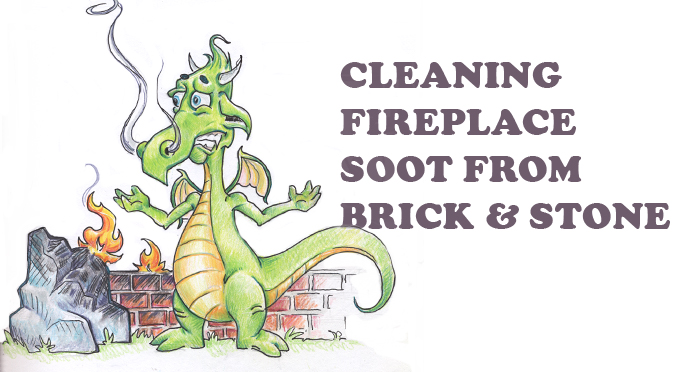
Everyone enjoys a nice, roaring fire, but very few of us like the black build-up that can accumulate over time. Not only will it completely coat the interior, it’ll also stain parts of the exterior as well. When you use your fireplace on a regular basis, smoke and soot will billow out to coat the surface of the brick or stone that it’s constructed from. The mantle, the firebox and every other area can become dingy and ugly without periodic cleanings. Most people think that removing soot stains is an impossible cleaning chore due to the dark black color and the often delicate surface they are on, but as with any job, if you have the right tools, it can be pretty easy to get good results.
There’s no effortless technique, or magic trick that will actually eliminate soot stains, but if you put in the work, you can easily do a good job. If you’re sick of looking at the black stuff coating your fireplace brick, then follow the easy steps below to ensure you always have a clean fireplace.
What Are Soot Stains Anyway?
Soot stains are dark or black marks left behind by the incomplete combustion of carbon-based materials. They are commonly found in areas where there is a presence of smoke, such as fire-damaged buildings, fireplaces, chimneys, or areas affected by a furnace malfunction. Soot stains can also be a result of candle or oil lamp use, cooking mishaps, or even certain industrial processes.
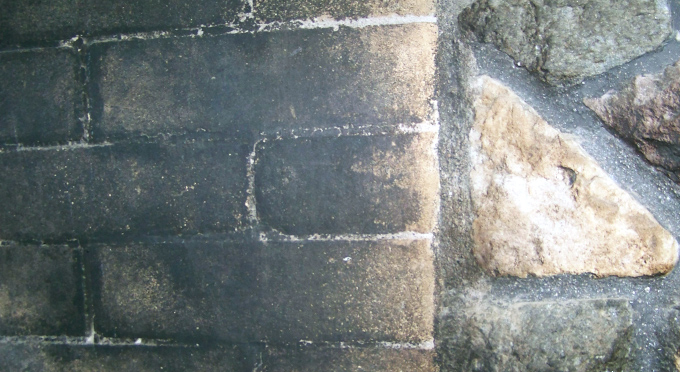
Soot is composed of fine particles that are released during the burning of organic matter like wood, coal, oil, or gas. When these particles come into contact with surfaces, they can adhere and leave behind stains. Soot stains are typically dark in color, greasy, and can be difficult to remove, as they have a tendency to smear if not properly addressed.
Soot stains can be found on walls, ceilings, carpets, fabrics, furniture, or any other surfaces exposed to smoke or combustion byproducts. They can cause discoloration, make surfaces look dirty, and emit an unpleasant odor.
Cleaning soot stains usually requires special attention, as regular cleaning methods may not be sufficient. Depending on the severity of the staining and the type of surface affected, different cleaning techniques and products may be required. In some cases, it may be necessary to seek professional cleaning services or consult with experts to ensure effective and safe removal of soot stains.
Cleaning Soot and Smoke Residue
Most often when people recommend solutions to clean soot and tar off brick or stone, they’ll suggest a harsh chemical cleanser, something involving a wire brush, or a solution made from acid. It’s a tough job, so regular soaps and sponges definitely won’t cut it, but you may not need to resort to stuff with toxic fumes or glove requirements either.
Each of the methods below will definitely work if you do it the right way, and try hard enough. Results will always vary based on a number of factors, but if you have soot stains that you want to remove, the list below is a good place to start. Some people think that it’s either too much effort, or too dangerous to consider tackling this job alone, and that’s why homeowners often consider calling a professional when faced with this task.
The following is a list of commonly used cleaning solutions and methods that are safe and effective when used on brick or stone. These are the most popular because they work the best, but they often require special steps or significant effort to get good results. You may already have some of this stuff on hand though, so for many people, one of the listed traditional methods could be the best choice. If you care more about results than you do finishing the job today, we also have a quick and easy method that is chemical free, and guaranteed to work. Just continue reading to see the full instructions that follow.
Formula 1: Soap and Salt
To make it: Mix one ounce of soap and one ounce of table salt with enough water to make a cream.
To clean soot stains with it, rub the mixture into the dirty brick surface with a cloth. Once the area is thoroughly coated, allow the solution to dry at least ten minutes and then remove it by scrubbing with a stiff brush.
The recommended soap type is regular dish soap, and when combined with some salt, it’ll become more abrasive to help you scrub away the black stains without harming the natural stone surface. When you let this thick solution dry and adhere to the surface, and then scrub it off vigorously, it can do a good job.
If you have thick build-up, this method may not be strong enough to take it off completely with a single application, so if you have some good results, but the surface is not completely stain-free, just proceed with a second application. When choosing a scrub brush, make sure to choose one that’s compatible with the brick or natural stone surface you are cleaning, that way you’ll avoid permanent marks and other damage.
The best part about this technique is that pretty much everyone will have these ingredients on hand, so you can get started right away.
Formula 2: Detergent and Ammonia
To make it: Mix together a thick solution of soap or detergent, pumice, a little bit of ammonia, and some hot water.
You don’t want the mixture to be a liquid. It should have a thick paste or gel-like consistency. The pumice will provide abrasive scrubbing power, and the detergent and ammonia will help to break down the stain, and loosen it from the surface.
To use it, simply paint the mixture onto the brick or stone surface, and then let it dry. Once the cleanser dries out, go in and rub it off with a wet scrub brush. You are using alkali and a mild abrasive to remove the greasy soil.
Most people won’t have a bottle of pumice sitting on the shelf at home, but this technique can be effective when you do get all of the ingredients together. It may not be safe for soft, natural stone, but for regular bricks, it can be a good choice. As with the previous method, if you’re able to remove one layer of soot with a single application, but the surface still looks dirty, then a second application may be required to finish the job.
Formula 3: Naphtha Soap
To make it: Shave a bar of naphtha soap into a container, and add in 3 quarts of water. Bring the mixture to a full boil on your stove top, and cook until the soap melts. Once the ingredients are mixed, and the soap is melted and mixed in thoroughly, allow the solution to cool. After it cools, add in 1 cup of ammonia, and one pound of pumice. Mix thoroughly to finish.
To use it, take a scrub brush and work it into every soot-stained spot, and then let it stand for an hour or more. Once it looks visibly dry, come back and scrub it off with a stiff-bristle brush. Rinse all of the goopy gray stuff away with warm water, and then finish it off by washing the area again with a medium to strong detergent. Give the whole area a final rinse to fish the job, and once dry the surface should look pretty clean.
This is like a more natural and Eco-friendly version of the regular detergent formula above it, but you may be surprised at how well the natural brick performs when compared to liquids with more harsh chemicals.
You will definitely have to put in a little more time and effort to finish making this formula, but when made and applied correctly, it will help you to get rid of the black stains in and around your fireplace.
Formula 4: Trisodium Phosphate
To make it: Dissolve 8 tablespoons (1/2 cup) of Trisodium Phosphate (TSP) or Spic & Span into one gallon of hot water.
To use it, apply the solution with a stiff scrub brush, and then scrub the brick surface thoroughly. The black stains should loosen, and once that takes place, rinse the area with plenty of warm water. A single application may not remove everything, so repeat the process if the soot or greasy stain is still visible.
If the initial solution is not doing a good job, you can increase the concentration of Trisodium Phosphate. Add up to 1 cup per gallon of water.
This is a very strong solution; avoid getting on skin, carpet, or fabrics. Acid is dangerous and destructive, so it may be better left to the pros, but if you do decide to try it, just make sure to take all of the proper precautions. You won’t want the acidic cleaning solution to touch your skin, your carpet, your clothing, or pretty much anything but the brick.
If used safely and carefully, you can certainly get good results with this formula, but you should probably save the acid for stains that other techniques leave behind. It won’t be that great for thick soot build-up, but it has proven to eliminate black marks that regular detergents leave behind.
Formula 5: Distilled White Vinegar
To make it: Use plain old white vinegar at full strength, or dilute with some amount of water. To make a medium-strength, all-purpose solution mix together three parts vinegar with one part water.
Use a cloth or brush to apply the cleaner, or spray it on, and then use a cloth or brush to scrub and wipe the stain off. If you try this formula, be sure let the cleaner sit for a while, especially if you’re trying to remove heavy build-up.
Although it’s safe and natural, it’s also a highly versatile cleaner. When applied to soot stains, it’ll break down the tough creosote build-up to make it easier for you to remove. Vinegar won’t be quite as powerful as some of the other methods available, but you probably have some at home already, so it’s a good option to try if time is limited.
Formula 6: Borax
To make it: Mix together 2 Tbsp of borax, 4 cups of water, and 1 Tbsp of regular dish soap.
The borax and detergent combo will offer improved results for certain surfaces and situations. Plus, it doesn’t have the abrasive component, so you can use it on softer stone surfaces that might be too delicate for other options. You’ll apply this similar to the soapy formulas above, but this one is slightly different, and some people like the results better.
To use this formula, apply the mixture to any soot stains you see in your fireplace by using a scrub brush. You’ll want to scrub it in, and then let it dry. Once the cleaning solution dries, scrub the area clean, and then rinse it thoroughly. This mixture will work well to break down the build-up, and help you remove it, but it may not be abrasive enough for really tough stains.
Step By Step Cleaning Instructions:
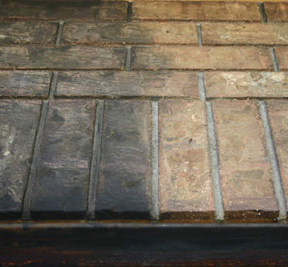
Once you decide which cleaner you want to use, the overall method of cleaning will be pretty similar. To avoid trouble and get the best results, follow the instructions below to remove soot stains using one of the formulas mentioned above. You can also follow these steps using a cleanser you like better. The general steps and tips below will help anyone achieve better results when cleaning soot stains from fireplace brick or stone.
- Clean out your fireplace. Make sure all of the wood is out, and the whole area is completely cool. Also take out any grills or racks you have in place, and sweep out any loose ash or charcoal. After sweeping, go in with a vacuum cleaner to remove any last remaining particles. One you get the area completely prepped, you’ll be ready to move on to the actual cleaning.
- Wet Down The Area. Adding water to the surface of the bricks or stone will aid in cleaning, and help to reduce any mess caused by stuff flying around, but it will also make a different kind of mess if you’re not careful. Position a drop cloth or other protective covering first, then use a spray bottle, masonry sponge, or wet rag to saturate the surface. When you wet the bricks first instead of just applying your cleaner, you will always get better results. If applied first, the cleaner will just soak into the porous brick or stone material, and you won’t get much cleaning done, on the surface, before it’s completely absorbed. When you let the material absorb water instead, your soaps and cleansers will remain on the surface to scrub away the soot stains like you want.
- Mix Up Your Cleaner. Take a look at the formulas above, and chose one depending on your needs. It’s always best to start with the most mild solution possible, and then increase strength as needed. This way you still get the job done, but you won’t be using harsh chemicals or unnecessary cleansers for soot stains that would be cleaned with less effort. You can easily complete the job with a homemade mixture from the list, but you can also choose other effective cleansers not mentioned.
- Scrub The Surface. Before you start to scrub and clean, you’ll need to apply your cleaning solution first. Some will be thin and safe enough to put in a spray bottle, but with others, you may have to apply them with a brush, sponge or rag for best results. To get the surface clean, make sure to work on small areas before moving on, and always work top to bottom and left to right to avoid dirty stuff getting on newly cleaned surfaces. When you avoid trying to scrub the whole fireplace at once you also avoid the frustration that comes from dried out bricks and soaked in cleansers. Keep the surface nice and damp the whole time, and the job will be way easier.
- Rinse The Area. Once you get one spot clean, make sure to rinse it thoroughly before moving onto the next spot. If you don’t, some of the soot you took time to loosen and lift will dry back in place to become a new stain. If you rinse the area before continuing to clean other stains, the results will remain. The easiest way to rinse is to use a sponge or rag, and a clean bucket of water. Simply dip in to saturate the sponge, then wipe up the loosened black stuff. Whenever your water gets too dirty inside your bucket be sure to switch it out to avoid contamination with the clean bricks.
- Get The Spots You Missed. As you get closer and closer to a completely cleaned fireplace, you’ll start to notice some spots you missed, and others that are not quite cleaned all-the-way. Simply go over these areas again, and most will begin to look clean, but you may encounter some more stubborn spots. For these areas, try a stiffer brush or abrasive pad to scrub the surface, or spot clean with a mild abrasive you can make. Just mix baking soda and a small amount of water to form a paste, and then use a toothbrush or small scrub brush to apply. A simple scrubbing action with this paste should help to loosen and lift any stubborn soot stai.
- Repeat The Process. If the first method didn’t get you the results you wanted, it’s time to switch solutions, and try something a little more powerful. Keep in mind that the longer it has been since you last cleaned your fireplace, and the amount you use it will determine how tough the job is. You won’t be able to remove thick layers, or several layers at once, no matter which method you choose, so if you get decent results with one formula, you may want to just apply the same formula again. For some cases, several applications will be the only way to get your brick or stone mantel completely clean.
- Test First. When using a new cleaning solution, always test it in a less visible spot to ensure that it will both work well, and avoid damage or reaction with the surface you are cleaning.
The Downside
All of the traditional methods above involve using a stiff brush to scrub away the soot. Using a scrub brush and water would produce some level of results too because it’s the elbow grease doing most of the cleaning, not the solution you’re using.
If you want to save yourself time and effort when cleaning soot stains from brick, stone walls, carpet and more, try using Quick’n Brite. You may still have to break out the scrub brush to help it penetrate layers, but you won’t be sweating and straining like you would with less effective cleaners. Use the directions above to tackle this job like everyone else, or continue reading to discover a faster, more effective way of cleaning soot stains.
The Easy Way to Clean Soot Stains
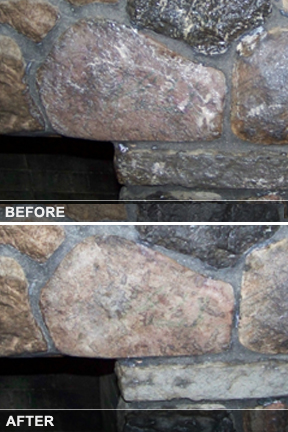
Using Quick ‘n Brite is one of the easiest ways to clean hundreds of things all over your home, office or vehicle, but it works great on soot, smoke stains, creosote and tar specifically.
It’s an enzyme cleaner, so it’s designed to break apart, and remove organic stains and build-up with little effort on your part. There are no chemicals or harsh substances to worry about, and you won’t have to drive yourself crazy scrubbing either. Quick n Brite will make quick work of any soot or tar stain on any surface. You don’t have to worry about it ruining anything you use it on and it is so safe you don’t need to wear gloves when you clean with it either.
Just apply the cleaner, and let it do the work for you. Your fireplace will be left looking like new after you clean it with Quick’n Brite, and it’s safe for use on natural stone, all types of brick, marble, slate and any other fireplace material. Black staining of any type caused by burning wood, can be completely removed in order to make your mantle, hearth and other areas look like new again.

You can use it on any part of your fireplace, inside and out, and it even works on metal racks and pokers too. Because there are no harsh ingredients, you never have to worry about where you use it, and because it works so well, you’ll get amazing results quickly and easily.
Using Quick N Brite To Clean Soot Stains:
STEP 1: Prep The Area
Ashes, wood chunks, and other debris will only make the job harder. Removing this stuff first will reduce the time it takes, and allow you to get down to the real problem, all of that black and brown coloring that is ruining the look of your beautiful fireplace. Use a vacuum or broom to remove any loose particles from the area you’re going to clean. This way you are only using Quick’n Brite to remove the stain and you are not creating a bigger mess by wetting ashes or other loose chunks. Once all of the problematic chunks have been escorted off the scene, it’s time to get your cleaner ready.
STEP 2: PREP YOUR CLEANER
Prep my cleaner? Yep. With Quick n Brite, you always dilute based upon the job you are doing, so sometimes there will be prep involved if you don’t already have it ready. For this mess it’ll be easiest if you have a supply of full strength paste, along with a bottle of all purpose solution in a spray bottle.
To make this solution, simply melt some paste on a low setting in your microwave, or use the convenient liquid concentrate. You’ll want to dilute down 3 tablespoons into a quart spray bottle of water. This will mix to form an all purpose spray that you’ll use to prep the soot-stained areas, but you can also use it for any type of regular mess all over your home.
STEP 3: Do The Cleaning

Once you have your Quick n Brite ready, you will want to spray the whole area down with your all purpose spray. This will serve two purposes. One is to wet the area you are going to clean, and the other is to begin adding on the cleaner. Once you have done this, you are going to want to switch over to the paste, and some sort of slightly abrasive tool for application.
This can be anything you want like a scrub brush, or abrasive sponge. You may even want to use a toothbrush or something small to get into the cracks and/or grout lines. The tool you use will depend upon preference and the surface you’re cleaning. If you have a smooth marble fireplace, you probably want to avoid the brush and go with something like our scrubbing cloth that is able to scrub surfaces without harming them.
After you have chosen your tool, you can begin to apply it. This is a pretty nasty stain to clean in most cases, so you need the paste, and you will want to apply it liberally. Take your brush, sponge or cloth and apply the cleaner sort of like you are waxing a car. Use circular motions without really scrubbing until the whole area is covered.
STEP 4: LET IT SIT
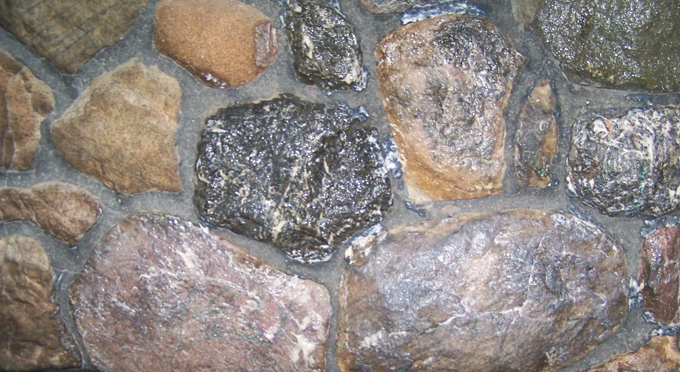
This is very important, so we give it it’s own step. For minor staining, let the cleaner sit on your brick or stone for about 10-15 minutes. For more severe looking fireplaces, you will want to wait 30 or more minutes. This gives the cleaner time to work. It will break apart the black stuff and make it easy for you to remove completely. It can be tempting to just scrub away like you do with regular cleaners, but this will only make your job harder. You will notice much of the dirtiness wanting to come off right away, but if you let it sit, you’ll be able to remove several layers of soot all at once, so your job will take less time, less effort, and fewer reapplications.
STEP 5: FINISH THE JOB

Once you let it sit, it’s time to actually remove the build up from your brick or stone. If you’re cleaning an area outdoors, then this part of the job is easy, but if you’re inside your home, you’ll need to be a bit more careful.
For outdoor cleaning, simply take your hose or a bucket of water to rinse the area and flush off all of the soot, tar and dirt. You may want to use your brush or sponge again, just to help it along.

If you’re indoors, the easiest, and least messy way to go is using a damp terry cloth towel. Simply wet it under the tap with warm or hot water. The heat will increase the cleaning power of your Quick n Brite and make things a little bit easier. So, just take this towel and sort of buff the stain away. You will see, right away, that the black stuff will come off of your fireplace and transfer to the towel. The towel will get totally dirty as your brick or stone fireplace begins to look better and better.
One and Done
In most cases, a single application will do the trick and make the dirty brick surface look like new again. For tougher build-up, or if it has been a long time, you’ll probably want to go over it again a second time for best results. If there are many layers of staining and soot built up on your fireplace, it’s possible that it will take 2-3 applications to get it perfectly clean.
With Quick n Brite anyone can achieve professional looking results when cleaning the brick or stone on their fireplace. You can use it on the hearth, the mantle, the screen, glass doors, surrounding walls, the carpet in front, and more.
Quick n Brite will remove smoke, soot, creosote and pitch. The pictures on this page are actual photos that are not in any way doctored. We used a SINGLE application of Quick n Brite to get these results. If we had applied it again, we could have gotten the brick and stone even cleaner.

You can notice a significant difference in color from the before to after pictures with only using it once. All areas are lighter in color, and more natural looking now that the layers of black gunk have been washed away. This particular stone has probably never been cleaned prior to this, and there was very little soot or smoke staining left on the rocks after going over it once. If we had applied the cleaner another time it would have completely removed decades of grime to fully rejuvenate the look of each part.
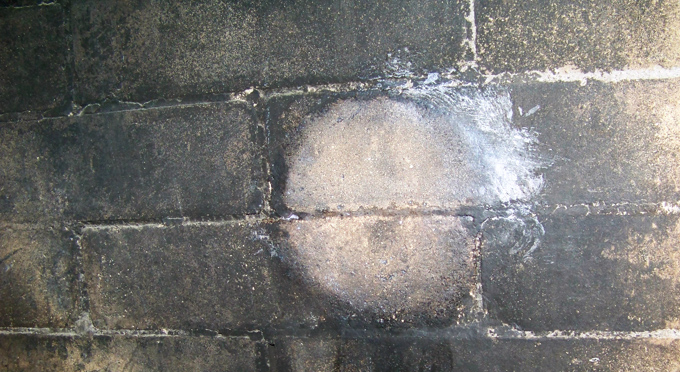
Buy it for your fireplace, and make it easy to clean soot stains on any surface, but then use it everywhere else when you’re done. Quick’n Brite is the best stain fighter, tub and tile cleaner, carpet shampoo and more. It has hundreds of uses unlike other specialty cleaners. It is also 100% biodegradable and chemical-free. It is totally safe around children and pets, yet works better than virtually anything else on the market.
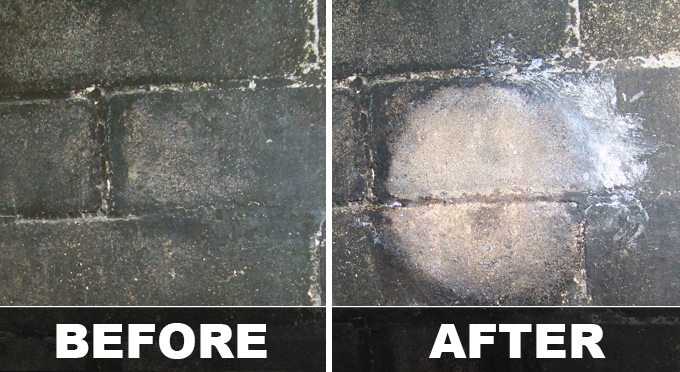
Guaranteed Performance
In case you are still undecided, Quick’n Brite comes with a full money back guarantee from the manufacturer and a 100% satisfaction guarantee from us. If you are not happy, or it doesn’t work like we say it does, you can return it for a full refund.
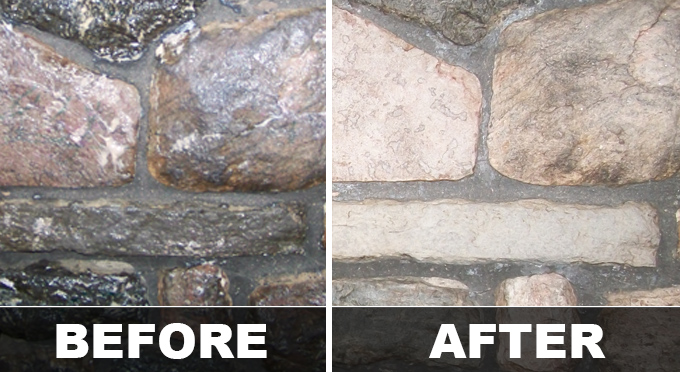
Other Stuff You Can Use For Cleaning Soot Stains:
If you don’t want to mix your own cleaning solution, or if you have some of this stuff on hand for other reasons, the following list includes some other stuff you can use to clean soot stains on brick or stone.
- Scrubbing Bubbles. Although it’s intended for use in bathrooms, and on smooth, non-porous surfaces, many people swear by this off-the-shelf cleaning product for it’s ability to get a fireplace clean.
- Dish-washing Detergent. Plain old dish soap, or the stuff you put in your dishwasher may also do a good job at cleaning brick and stone. You can squirt it on directly, or mix with water to create a solution. For small areas of staining, this is a good place to start for most people. There is no risk of damage, and the results may just surprise you.
Safety Tip
If you do decide to use one of the harsh cleansers to finish this job, be sure to take the proper precautions. Eye and hand protection should be worn at all times, and extra protection for surrounding areas should be employed.
Regular Fireplace Maintenance:
Good fireplace maintenance can increase efficiency and lead to a reduction of soot stain build-up, so proper care is one of the best ways to avoid soot stains in the first place. Frequent cleaning will not only improve the appearance of the brick and stone, it’ll also ensure that each time you wash off the soot, there will be less there to remove in the first place. When the job takes less time, it becomes more likely that you will start it, and also more likely that you will finish with good results.
The bottom line is that in order to ensure safe and efficient use of your fireplace, while also reducing maintenance, it’ll need regular care and cleaning. Creosote, a flammable tar like substance, accumulates in the chimney and flue and can be hazardous if it’s not removed. Give your fireplace and its accessories a routine cleaning throughout the wood-burning season to eliminate an accumulation of soot, ashes, and creosote tars. Here are some easy steps to take to improve results when cleaning, and keep your fireplace clean longer:
- Burn only seasoned, well-dried wood. This will eliminate soot, smoke and creosote accumulation.
- Inspect the firebox, flue, and chimney annually. Check for creosote build-up or blockage.
- Vacuum the hearth area weekly. Make sure all the embers have been extinguished for at least 12 hours.
- Do not use water to drown a fire unless there is an emergency. It will make a huge wet mess, and a nasty paste out of the ashes.
- Never use an abrasive cleanser inside your fireplace unless you are sure it is safe for the job. Many of them contain dangerous chemicals that will leave a flammable residue.
- When cleaning your fireplace, sprinkle damp coffee grounds over the cooled ashes to keep down the dust.
Stop searching the internet for the best way to clean soot stains on brick and stone. There is no easy way to get this job done, but anyone can get good results with the right technique, and a good cleaning solution. You could spend a bunch of money to call in a professional, but you could also roll up your sleeves, and get the same level of cleanliness, using your own hands.
Still Not Convinced? Read more about cleaning the inside of a fireplace.
Tip Contents
- What is Soot?
- Cleaning Formulas
- Cleaning Methods
- The Easy Way To Remove Residue
- Step By Step Instructions
- Guaranteed Results
- Other Stuff You Can Use
- Regular Maintenance


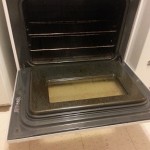
 Ordering Info
Ordering Info Customer Service
Customer Service Follow Us
Follow Us Search For Stuff
Search For Stuff Find Us
Find Us Call Us
Call Us Pay Us
Pay Us

What kind of “Soap” do you recommend for cleaning a brick fireplace (exterior stone)?
Quick n Brite is perfect for this surface too. It will deep clean, but you don’t have to worry about it ruining the surface. The general rule is that if you can get it wet with water, it is safe to use Quick n Brite on it. This cleaner is extremely safe to use, and you don’t have to worry about wearing gloves, or breathing dangerous fumes. Just follow the instructions above to achieve outstanding results. Click Here to order Quick’n Brite.
Have several old tin toys that have been damaged by soot from a house fire. (Not burned, but covered w/a layer of soot.) Will not come off with a light scrubing w/simple green. Any suggestions are appreciated. Material is stamped tin with a lithographed design on surface.
Bill
Quick n Bite seems to work the best…giving rusty or soot-stained items a light scrubbing from a small wire brush can help remove some of the staining before and after applying Quick n Bite.
Thanks for the tip!
Bill-
We would recommend Quick’n Brite for this application too. It is safe to use on any surface you can get wet with water, and is chemical-free and non-toxic so you don’t have to worry about it damaging any surfaces. Quick’n Brite has been proven to easily remove suit and smoke stains from a variety of surfaces.
What do you recommend for cleaning a brick fireplace (exterior brick)? This is the area right above the fireplace and below the mantle, so I don’t want to use anything that will discolor or make a stain or greasy spot. I want to use something safe that will work, but not damage my brick, because it would be very noticeable. I don’t want to ruin the looks of my fireplace.
Thanks so much,
Cindy Brown
I just sprayed Scrubbing Bubbles on mine, scrubbed with a brush and wiped away with a wet cloth – worked like a charm!
Good grief. Wow!? Really?! Nothing like spraying on some flammable stuff that you shouldn’t even be breathing in order to clean an item in your living room that you intend to start on fire. Direct from the MSDS(material safety data sheet) for this product: CAUSES EYE IRRITATION. Avoid contact with skin, eyes and clothing. Do not puncture or incinerate. Avoid breathing vapors, mist or gas. Keep away from heat, sparks and flame. Conditions to avoid : Heat, flames and sparks. Materials to avoid : Strong oxidizing agents and strong acids. Hazardous decomposition products: Thermal decomposition can lead to release of irritating gases and vapours.
Moral of the story: Don’t just use anything when cleaning, especially fireplaces. You got lucky because it worked to remove the grime. Please don’t test your luck any further though. Do yourself a favor and rinse any area cleaned very well with water. Even if the residue doesn’t catch on fire, it may heat to release dangerous gases once you burn wood.
You would use the same method as outlined above. Because Quick’n Brite is all natural and doesn’t contain harsh chemicals, you don’t have to worry about it discoloring or otherwise ruining any surface you use it on. It is totally safe for exterior brick or virtually any other surface with this type of build-up. Give it a try, and you will have great results.
how do I clean soot off the white painted walls?
Luckily, with Quick’n Brite, you can do it in much the same way. The all natural formulation is gentle on surfaces and tough on stains at the same time. It won’t ruin the wall or effect the paint. Just take a spray bottle of all purpose solution (3 tbs. in a quart of water) an spray it on the soot. Let it sit for just a bit and then take a damp microfiber cloth and wipe it clean. If the black stain is really bad then you may need to resort to the paste full strength, but in most cases, the spray and wipe method will work just fine.
That’s why i just hire someone to do it for me.
I didn't know quick'n bright worked for cleaning soot. I'll have to start recommending that to my customers. Great blog btw.
Have you had any success with this product in cleaning the fire box of pre-fab inserts?
Quick n Brite can clean nasty black build-up off virtually any surface. Certainly the fire box on your fireplace insert would be included. You would use the same procedure as above, and you will end up with the same great results. Try it for yourself and you won’t be disappointed.
Creosote has discoloured the outside chimney bricks over a number of years.
It’s a light brick, the stains are severe and it looks very ugly.
Looking for a solution please.
Creosote, smoke, soot and everything else can be removed with Quick n Brite. Of course creosote is the worst of the lot, but as long as you are using the paste full strength, you should have good results.
I find it very interesting that there aren’t any comments from people who have actually tried and or used the product. Sure would be nice to get some feed back from the consumer, instead of ‘promises’ from the seller.
Agreed. It would be nice to see some of you folks come back and tell us how well it worked. But may we point out that you also don’t see any complaints here either, and we literally approve every comment from non spammers to this page. We would also like to point out that it is much more than a promise we are offering. It is a full blown money back guarantee backed up by more than 20 years of experience with this awesome cleaner. Pretty much anyone that tries it would agree that it works great. Despite the full money back guarantee we also see a less than .05% return rate on this item. We say it works, because it does actually work.
Unfortunately, this did not work on cleaning smoke damage from my outdoor fireplace brick.
Did you let it sit? Did you use the paste full strength? These are the two most important steps. If used correctly, Quick n Brite should work very well for this kind of job. This is a tough job, so you will always want to use the paste version of Quick n Brite for the best results. Also, letting it sit is quite important too. It is the time you let it sit that most of the cleaning takes place, not the scrubbing you may or may not have to do afterward. Let the cleaner sit on a mess like this for roughly 30 minutes and it will work much better, and the black stuff should clean right up after that. If the build-up is severe, it may take more than one application to produce a perfectly clean surface. If there are multiple layers of grime, you will only be able to remove so many layers with each application. Please let us know if you need any further help getting this to work for you.
The bricks round our fireplace are handmade and porous. Will this stuff not just sink in?
Nope. It wont sink in. It is a gelatin type of paste that is more solid than liquid. You can dilute it if you want, but you can also use it as is if you are worried about your stone. If left in paste form, it should not cause you a problem.
I just used some 409 to clean to soot off my bricks since it’s what I had on hand. Worked fine!
Sounds like you got lucky, but we are glad to hear that it worked! Clean bricks=better
[…] This post was mentioned on Techwench […]
Thanks TechWench 🙂
where do you buy quick n brite?
It is pretty hard to find locally, but you may have luck at a home show or similar venue in your area where it would be demonstrated and sold. You can also order some here: http://www.simplygoodstuff.com/quicknbrite.htm
I tried Quick n Brite on my brick fireplace to remove the soot and absolutely loved it! I could not believe the results! I have tried various other products to remove soot and creosote that did an okay job but there was always a reside still left behind (and many of the products were so toxic I wasn’t wild about having them in an area where I would be lighting a fire soon!) I was recommended Quick n Brite by a friend because it is a safe product without chemicals so I didn’t have to worry about my children or pets (which I loved). I put the paste on my fireplace with a stiff brush, let it sit about 30 minutes then came back and wiped it off with a damp terry cloth towel. It was like brand new, I have not seen it that clean in 20 years and I did not have to scrub my arms off either! I have been recommending Quick n Brite to all my friends since then and everyone I have shared mine with has been very pleased as well. Great product.
Thanks Nicole. This almost sounds like a fake review. We didn’t pay your for this did we? Seriously though, it is always nice to hear about real life success stories. If anyone else has had results like this, we would love to hear about it.
A company should be highly experienced and must have cleaners that can be relied on.
First, you will need to fully understand your cleaning choices so that you can choose
a one that would suit your needs well, since there are a lot of them on the market to select from.
We believe that organic carpet cleaning is the safest method for your home.
hi,after knocking a whole in my chimney breast for a wood stove i have found an old stone fire surround i am wanting to keep it as dont see the point of covering it up with anything else.The house is about 100 years old and this looks like it was put in then it is completly black i have tried wire brush and brick acid and either has shifted it,i was looking at getting someone it to shot blast it but think this would make to much mess and be quite costly,anyone any ideas ?
QuicknBrite will work, and it is way more gentle. It may take a bit more effort due to the age of the build-up, but it should help breathe life into that old stone. Make sure you let it sit long enough and it will break down that black layer and allow you to lift it off.
Hi
I notice your post about QuicknBrite about your fireplace I have the same issue and just wondered if you used it and what was the outcome?
Many Thanks
Jamie
Not worth the shipping, has no cutting power, I even tried full strength, like trying to clean with plain water. Do not recommend.
Where do I get quick and brite cleaner
The best place to get it is directly from us. Find it here: http://www.simplygoodstuff.com/quicknbrite.htm
That is interesting that the abrasive cleansers can sometimes leave a toxic residue. It would definitely be a bad thing for my kids and our dog to ingest such toxins. Additionally, the damp coffee grounds is such a cost effective and downright neat way to create dust repellent.
Yep. You really have to be careful when you have kids and pets in order to prevent exposure to dangerous substances.
Thanks for sharing very informative article about cleaning the fireplace. The major part of owning a fireplace is upkeep, and a stone hearth should be cleaned on a regular basis to keep it looking great.
We tend to use the Formula 1 you mentioned here. Uggh. I should have read this post before. But anyways, thanks! Really helped us a lot.
I appreciate the tips for getting the soot and smoke stains off of brick and stone. However, I have some smoke damage in my kitchen as well. Will the chemical free methods, like the soap and salt solution, work on drywall? Alternatively will the quick’n brite work on the wall?
Thanks, I was able to dig out enough information and ideas by reading through the whole thing, BUT, it’s an excessive article that has a strong hint of unhidden bias, as for selling a specific product — Q&B:
1. OK, good enough, Q&B may really work, I just don’t know where to get it — willing to look a bit for it, but generic cleaners would likely work just as well, while readily available to anyone, maybe already in the closet or under the kitchen sink.
2. The article was supposed to be about cleaning off soot stains, but instead goes through a long and dreary leadup about what NOT to do, and about fireplace maintenance, etc. We’re not idiots, most of us have nice, clean, and well-maintained fireplaces …….. with soot stains on the rock or brick: we just want to know a good way to clean those off.
3. The article immediately disparages the tough and tedious use of a brush, but eventually gets back around to using a brush for Q&B — of course! Do you really think most people are so helpless that they expect to simply spray or dab something on, walk away, and it’ll be as good as new? NO, everyone knows that cleaning anything can be expected to take a bit of work, and in this case for a rough surface, a brush (or a pressure washer — not practical indoors) is the most sensible thing to use. The suggestion of using your special cloth instead of a stiff brush, to avoid damaging the rock or brick is just laughable, obvious to everyone who reads it, and a discredit to Q&B — a really good cleaner that doesn’t need any of this BS to pump it up.
Thanks for all of the great tips you have listed on here. I can’t wait to try some of the mixtures you have listed. And I will not be trying anything like scrubbing bubbles or anything with a heavy amount of chemicals. That can really make for a bad situation. Thanks again for sharing this great information!
That’s a brief post about cleaning fireplace. You have really defined all the points in a great way so that the people can easily get rid of this situation. I keep reading your posts and i always found it helpful.
Most people wouldn’t consider it brief, but we’re glad you liked it and found it useful. Thanks for the feedback!
Where can I buy it?
Zip code area 98177
The best place to get it is here: https://www.simplygoodstuff.com/quicknbrite.htm
I used Soft Scrub with Bleach and a soft bristle brush to clean my bricks that are painted an off white. It works pretty good.
Thanks for the tip. Hopefully it helps someone out.
Thanks for the tip Stacy. We’re glad to hear that it worked for you.
I liked that you mentioned that having a fireplace requires care and cleaning. I think that if I was going to get a fireplace then I might want to get a professional to clean it so I don’t break anything. your house might have soot all over if you don’t clean your chimney.
Thanks John. Doing it yourself can be a daunting proposition, but when executed properly, you can end up with better results while saving a ton of money.
Is Quick n Brite available in South Africa. If so where???
We ship it internationally, but we would not know of a store local to you unfortunately.
Question: Could you share any before/after pictures for removing creosote? We have some that’s slowly oozed out of an old, unused chimney and looks messy on the brick. It’s thin in some places, thick in others and like tar. Based on there not being any pictures here I’m concerned it may take several treatments.
My parents are going to be building a cabin in the mountains sometime next year, and they want to have a chimney built out of stone. You made an interesting point when you talked about how it is important to only burn well-dried wood in a fireplace that is made out stone. I’ll be sure to share this information with my parents so that they can know how to properly maintain their fireplace once their cabin is finished.
I like that you pointed out that the efficient use of our fireplace will be possible if we have it cleaned and regularly cared for. With that in mind, we should hire an interior brick cleaning service this month to check and service our fireplace. We have used it a lot during the winter and fall season, so there must be lots of creosote or other debris inside it that needs to be removed.
Cleaning fireplace soot is no walk in the park. Having to clean it can get complicated.